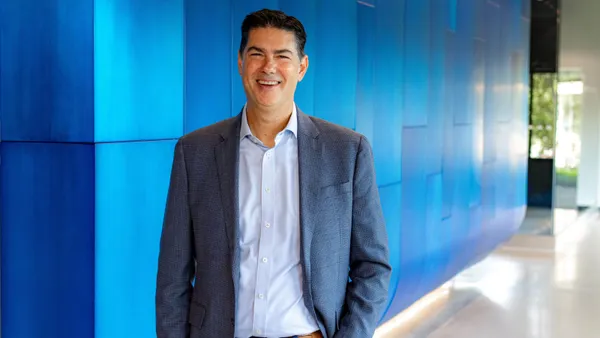Mortenson President Dan Johnson celebrated his 30th year with the Minneapolis-based construction giant last week. During his time at Mortenson, Johnson has seen the company launch new divisions, outgrow its headquarters and adapt to a rapidly changing industry landscape.
"When I started with the company, the industry was still very much a rip-and-read, competitive bid kind of industry," he said. "It has evolved into a professional services, very sophisticated, technology-driven, solutions-driven business."
In the last few decades, Mortenson has grabbed attention for its growing renewable energy construction sector — which Johnson called "the most exciting part of our business right now" — and its high-profile sports stadium and arena projects. The builder just wrapped up construction on the $1.1 billion Vikings U.S. Bank Stadium and is set to begin construction on the $524 million Milwaukee Bucks arena.
In an interview with Construction Dive, Johnson discussed how Mortenson grew into a major industry player, as well as the broader construction industry direction to a more collaborative approach to projects and the ramifications of new technological innovations on the "job site of the future."
Editor's note: This interview has been edited and condensed for clarity.
You mentioned where the construction industry isn’t in terms of other industries. Do you think there are certain areas where construction lags behind?
JOHNSON: If you look at the productivity curve, construction productivity really hasn't changed since the 50s and the 60s. In fact, if anything, it's declined some. Whereas if you look at manufacturing productivity through that time era through lean techniques, robotics, prefabrication, supply chain solutions, speed to market, one-off manufacturing — it has all led to astounding innovations that really provide a road map for our industry to follow.
Why do you think construction hasn't been as fast to catch onto those trends?
JOHNSON: The industry is very fragmented, so a typical contractor in any given market, if they have 10% market share, that's a huge market share. There isn't a lot of extra money to spend on innovation and research and development. I think what's changing that is because of the size of our industry, there is a momentum and a demand from our customers to innovate and provide more value, more cost-effective solutions, reduced timeframes, higher quality. Probably what's enabling that more than anything right now is technology. Technology is quickly changing our industry in ways we haven't seen before.
What are some technology innovations that you think are going to have the biggest impact on construction?
JOHNSON: Right now, the one that's having the most impact for us is building information modeling, virtual design and construction. When you combine that with the collaborative tools that are now available in the advent of mobile devices, we are literally collaborating real-time, anywhere, out on the job site with all the stakeholders. That's accelerating a lot of the innovation. That technology is also making it possible to do offsite assemblies, prefabrication. If you look at what we believe to be the job site of the future, the job site of the future's probably a lot more about assembling components that have been prefabricated in other locations, assembled in other locations, and delivered to the job site. And that's already happening rapidly as the industry's changing.
When did Mortenson embrace lean construction, and why do you think it's a methodology that is helpful for the industry?
JOHNSON: We embraced lean back in the late '90s, early 2000s. Primarily at that time it was focused on improving productivity in the field, and specifically related to our wind business. From that, it's grown to really all aspects of our business, and even the aspects of our business that are more the management side. The advent of integrated project delivery, collaboration, the big room, colocation, all of those things are not only things that Mortenson's doing, but the industry's moving in that direction.
Mortenson emphasizes integrated project delivery and collaboration. Is there an overall industry shift toward more collaboration in contracts and project delivery?
JOHNSON: Yeah, I'd say what we're not seeing a lot of, at least in our markets yet, is the triparty agreement, in other words what some people call capital IPD. What we are seeing is a dramatic shift into all forms of agreement being much more collaborative and much more interactive between all the stakeholders. And that's where we're really seeing the innovation because rather than it being just a handful of projects doing full IPD, we're seeing the broad set of projects all incorporating facets of what really is the right thing to do and common sense thing to do.
Why do you think it's taken so long to have this shift? Why has it stayed so traditionally separated?
JOHNSON: I think our industry is a prisoner to bids. There's a lack of trust that a collaborative, open-book process is going to lead to the same competitive price that if you finish the drawings and put it out to bid. There's a lot of folks in our industry that have grown up that way. They trust it. It's easy to go to your board of directors and tell them you're over budget but we've got three bids, as opposed to we worked in a collaborative design set and we're over budget and this is the best price. It's just hard, it's really hard.
Last year, Mortenson announced you were launching a new energy storage unit. Why did you decide to make that new leap into the market?
JOHNSON: It's actually a very natural extension of our renewable energy business. Probably the biggest concern about renewable energy is it's not on-demand. Solar produces when the sun shines, and wind produces when the wind blows, and that may not be the time you need energy. So energy storage has always been something that has been needed to make renewable energy a bigger part of our infrastructure and energy grid. The technology has now come into play, probably a lot thanks to the Teslas of the world, which are making large batteries more affordable. So battery storage is probably where that energy storage business will go.
Another segment we often cover is your sports construction division. How did you become a such a big name in stadiums and arenas?
JOHNSON: That started 25 years ago when we constructed the Target Center here in Minneapolis, which is the basketball facility. We really pursued that project because it was a big project in our backyard, not because it was a sports project. But through that process, we fell in love with the industry, and people liked what we did on Target Center, and they asked us to look at other sports projects.
It has literally grown one brick at a time, one sports project at a time, over that 25 years. We've always been very selective in not taking on too much work in that area. They are really demanding projects. They take our best people, and they take a certain type of person because they are so demanding. So we're very careful to be selective and very prudent in taking on the right amount of work. And we're very focused on making sure we deliver on time and early many times. We finished the Twins stadium two months early, and we just got our certificate of occupancy on the Vikings U.S. Bank stadium six weeks early. So when we finish a sports facility, done is done.
Have you found that working with owners and clients in the sports division is different than in other divisions?
JOHNSON: They're challenging projects, in that there's typically some public funding involved in them, as well as the private ownership part of it. They're very high-profile. It doesn't matter where I go right now, usually the first question people ask me is, 'How is the U.S. Bank Stadium going?' We're building a project that's just as large and complex as that up in Canada, it's a high-voltage AC DC converter station project. You know nobody will probably ever drive by it; nobody asks me about it. It's equally as challenging and equally as important for us, but it just doesn't have the same kind of emotional attachment and high-profile nature that these sports facilities do.
What are some of the biggest trends in sports stadium construction you've seen recently?
JOHNSON: The biggest thing, and it's actually a new business we're launching, is the advent of the high-tech mobile device, electronic fan experience. A big part of that experience is for people to show up and be able to have an online experience and interact with people both at the facility and back home, whether it be posting on Twitter or accessing apps that follow what's happening in the football world while you're watching your football game, or your fantasy team, or watching it on the scoreboard. Massive infrastructures are now being added to new stadiums and existing stadiums, so we are launching a business focused on that sports technology, primarily low-voltage digital antenna systems, and Wi-Fi systems.
The other thing we're seeing is the old sports facility was a single facility surrounded by a large parking lot, and that's really changed. These have become entertainment districts. So the Atlanta Braves stadium we're building in Atlanta, that's surrounded by office buildings, hotels, entertainment. That's much more the trend now, to create a whole entertainment experience beyond the sports facility. And that's really changing the neighborhood.
Is there a certain division of Mortenson that you enjoy the most?
JOHNSON: I'd have to say the most exciting part of our business right now is the renewable energy area, the wind and the solar. As much as we were on the ground floor of both of those businesses, I have to admit we could have never anticipated they would've taken off at the scale that they have. They have really provided a change in the long-term health of our energy grid. It feels good to me, it feels good to our team members, to be doing something that's good for our environment and good for the future of our country. We did our first wind project back in the mid '90s, and it's steadily grown from then.
It's interesting, for the early years, people coming out of college weren't really interested in those types of projects. They'd much rather go to the projects like our sports projects. But it's also clear that this generation has a much more altruistic view of the world. And the wind power and solar power are some of our most desirable groups to join out of college right now just because that new generation entering the workforce wants to give back, and they want to do something that is meaningful. So it hasn’t been very difficult to recruit new people into that part of our business.













